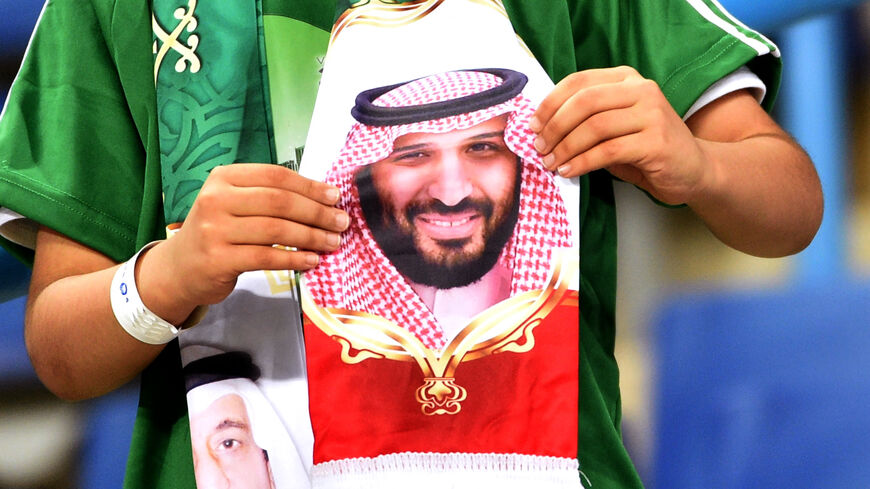Saudi Crown Prince Mohammed bin Salman (MBS) on Monday announced a shakeup of Saudi Arabia’s sports industry, which included the country’s Public Investment Fund (PIF) — of which he is chairman — taking ownership of four of its top soccer clubs.
The restructuring also includes the government offering several sports clubs for privatization from the fourth quarter of 2023. The changes are designed to make it easier for foreign investment to flow into Saudi Arabian soccer, to help the kingdom achieve its aims of raising its international profile for tourists and diversifying its economy away from hydrocarbons.
Dan Plumley, senior lecturer in sports finance at Sheffield Hallam University, described the move as “hugely significant."
“It was always likely to happen at some point given the Vision 2030 strategy of the country and sport playing a huge part of that,” Plumley told Al-Monitor. “It opens up the league to become a more commercially engaged project and brings the potential for outside investment into the league through commercial and broadcast partners."
He added, “Eyes on screens will be the key here, and bringing in the world’s best players will certainly help with that as we have already seen with Ronaldo."
The Portuguese forward joined Al-Nassr in December 2022 on a record-breaking two-and-a-half-year contract worth more than $214.5 million, according to some estimates.
Simon Chadwick, professor of sport and geopolitical economy at Skema Business School in Paris, said MBS’s move is a “privatization in inverted commas” because the state is still going to retain a significant degree of control over the Pro League clubs.
“Clearly these clubs have been allocated to state-related entities to run them. The reason for that being is that the clubs are expected to perform a particular role for the government in terms of policy,” Chadwick told Al-Monitor.
Talk of privatization in the sports sector is nothing new in the kingdom — Saudi Arabia’s government announced its plans to take some of its clubs private in 2015. But there have been several occasions when Pro League clubs have been bailed out by the government after being in significant debt, even as recently as last year.
“I think it does mark an attempt to change the operating and business models of the clubs in the Pro League,” Chadwick said. “But it doesn't release them entirely from state control. And that is really important because these clubs are not intended solely to function as businesses … they have a geopolitical context to them as well.”
The professor highlights the powerful and impressionable impact soccer can have on a country’s place in the world, as shown with Qatar hosting the FIFA World Cup last year.
With this week’s restructuring, Saudi authorities are keen to attract inward investment into its sports sectors, in ways like shirt sponsorships from international brands in a similar way other, more established soccer leagues have done, to bring money into the country.
Chadwick said that Saudi teams also want to bring in huge broadcasting revenues for TV rights like the English Premier League does. Saudi authorities also want to see more overseas investments in Saudi teams.
MBS’s thinking regarding expanding Saudi Arabia’s global soccer influence is largely aligned with Vision 2030 and showcasing the country as a sports powerhouse of the future, Plumley said.
“They have already said they want the Saudi league to be in the top 10 in the world in the future, so it is an ambitious strategy but plausible in the long term,” he added.
Chadwick said it is about diversifying the economy away from oil and gas and getting the soccer clubs operating on a more commercial footing by only spending what they generate through revenues.
Soccer can also help the Saudi government bridge the gap in some of the kingdom’s socioeconomic changes, he said — for example, using the sport to help reconcile religious tensions between the Sunni population in the west of the country and Shiites in the east.
Furthermore, some 70% of the Saudi population is under 35 — and with soccer being the most popular sport in the country, many of those people will be fans and maybe even play themselves.
“There is a new, implied social contract within Saudi Arabia, which essentially is that if you want to live like 21st-century consumers in other countries, in Britain, in the United States, and in China and other parts of the world out there, then you can have top-class football — you can have big game football, football teams,” Chadwick said.
The experts believe that more top-flight soccer players will move to Saudi Pro League (SPL) clubs in the future, following the Ronaldo and Benzema transfers to Al-Nassr and SPL champions Al-Ittihad, respectively. Chadwick said that Saudi Arabia will likely want to recruit Ronaldo and other high profile signings as ambassadors for the country's bid to host the 2030 World Cup.
These players are soccer legends in the sunset days of their careers, but the SPL might find it harder to attract younger players.
“It will be superstars that will be the target in the first instance, some coming toward the end of their careers. But we could also see other players targeted, such as [up-and-coming] stars,” Plumley said. “The latter is trickier as the league is not as established as others in Europe, for example, but players could be lured by the money on offer and the revamped [FIFA] Club World Cup structure."
“There are no financial constraints on spending in the Saudi league like in Europe with FFP (Financial Fair Play), so there is no limit on what they could offer players in wage terms as it stands,” he added.
But experts believe it is still a long way off before the SPL can rival the caliber of the European “Big Five” leagues: the German Bundesliga, the English Premier League, France’s Ligue 1, Spain’s La Liga and Series A in Italy.
“The Premier League has a phenomenal global reach and is the destination of choice for most footballers at present,” Plumley said. “The Saudi League is aiming for the top 10 first, which is a more realistic ambition in the medium to long term. The Big 5 in Europe are still the clear market leaders, and there is a long way for any league to go to bridge that gap.”








